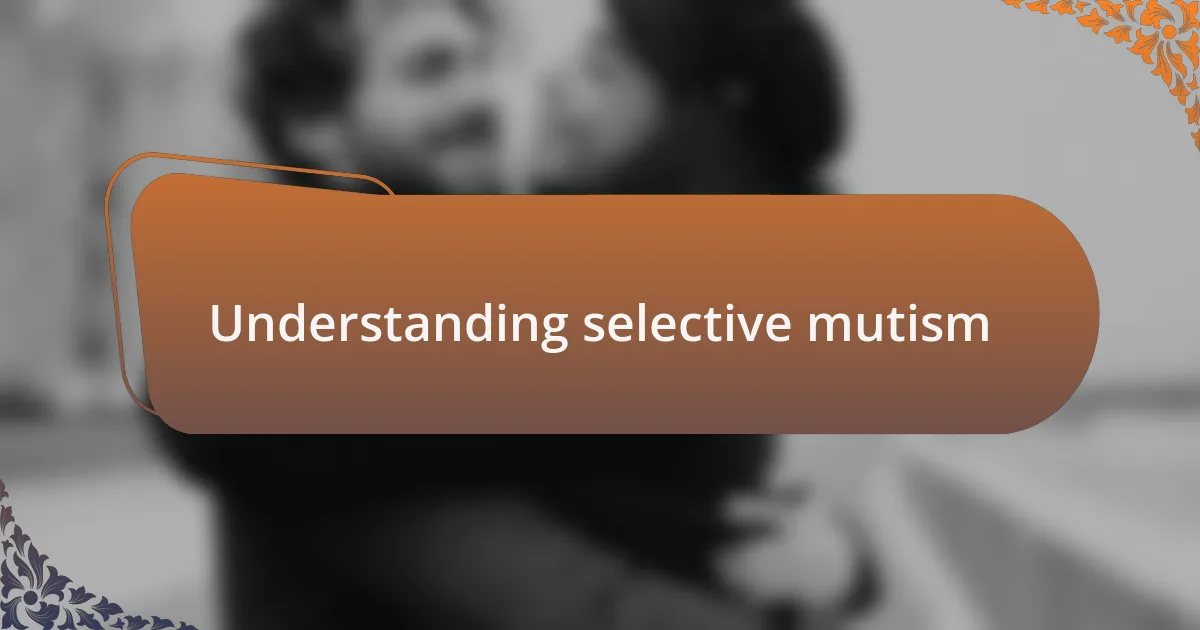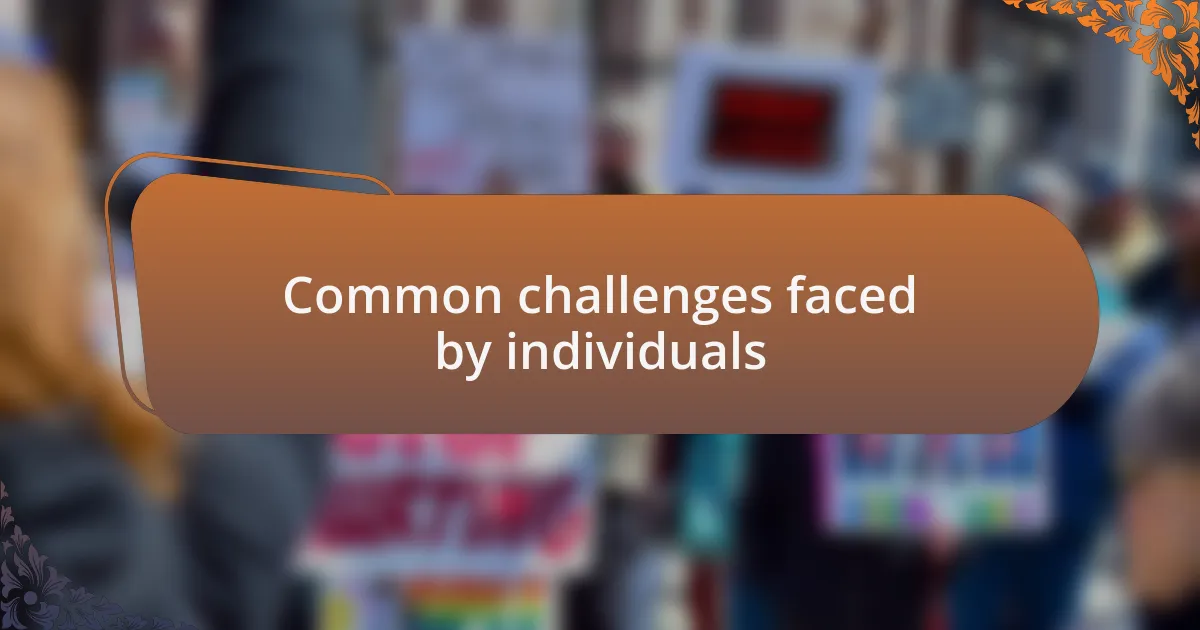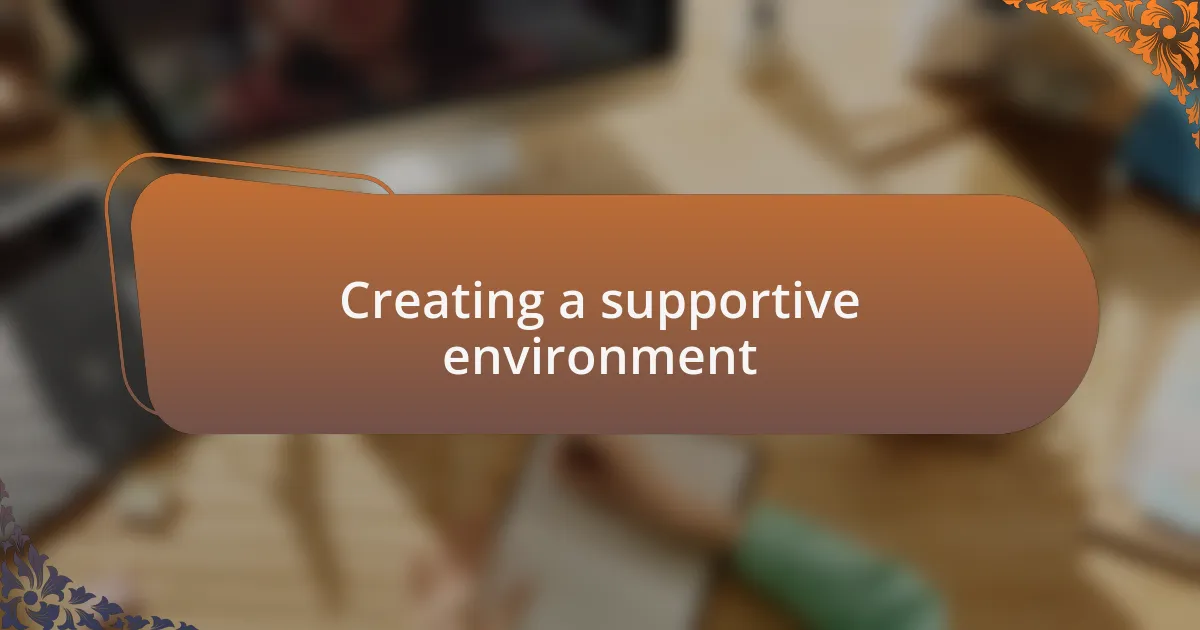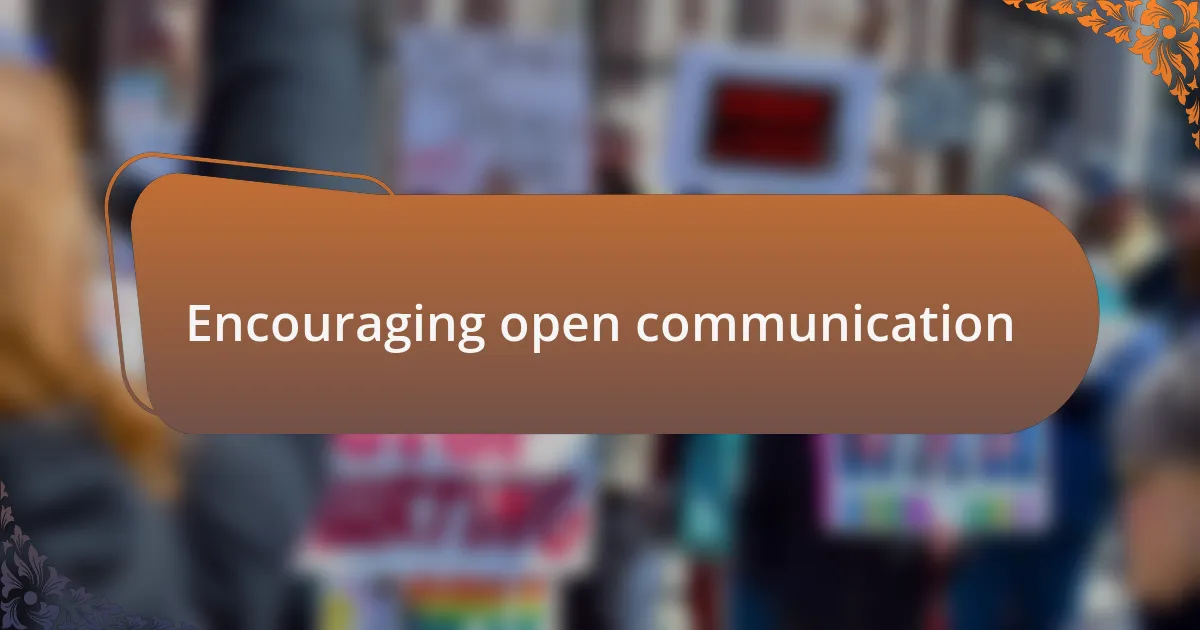Key takeaways:
- Selective mutism is an anxiety disorder affecting children’s ability to speak in social situations, rooted in fear of judgment.
- Creating a supportive environment, with patience and understanding, is crucial for helping individuals with selective mutism express themselves.
- Establishing routines, engaging in positive self-talk, and connecting with supportive peers can aid in coping with the challenges of selective mutism.
- Encouraging open communication through vulnerability fosters connections and understanding in relationships, facilitating progress for those facing selective mutism.

Understanding selective mutism
Selective mutism is a complex anxiety disorder that primarily affects children, causing them to be unable to speak in certain social situations, despite having the ability to speak in other environments. I remember witnessing a friend’s child struggle during playdates; he was completely silent around peers but would chat away with family at home. It made me wonder how isolating it must feel for children who want to communicate but simply can’t.
For many, selective mutism stems from deep-rooted anxiety, often linked to fear of judgment or ridicule. I once met a parent whose daughter had this condition; she explained that her daughter loved to sing at home but froze at school. This juxtaposition highlights how these children aren’t choosing silence; they’re grappling with an overwhelming fear that makes even the simplest conversations seem daunting.
Understanding selective mutism requires recognizing the emotional toll it takes on a child. Can you imagine having thoughts bubbling inside you, yet feeling powerless to express them? I recall feeling anxious myself in social situations, but that doesn’t compare to the daily struggles faced by kids with selective mutism. They need our compassion and patience to help them feel safe enough to find their voices again.

Common challenges faced by individuals
Facing social situations can be a minefield for individuals with selective mutism. I remember a story shared by a teacher who told me about a student who would shine in one-on-one discussions yet struggle to utter a word when classmates were present. It’s heartbreaking to consider how that child must internalize the pressure to communicate while feeling completely paralyzed by anxiety.
Another challenge is the misconception often held by peers and adults alike. I once observed how a bystander assumed another child was rude for not responding during a group activity. It really struck me how easily misunderstandings can lead to further isolation. How do we help others recognize that silence doesn’t equate to disinterest or unwillingness?
Moreover, there’s the emotional weight that comes with the fear of judgment. I heard from a parent who described the pain of seeing her child want to join in but retreat back into silence. In those moments, how do we reassure those kids that their voice matters? It’s crucial for us to foster environments where they feel safe, allowing them to express themselves gradually and at their own pace.

Strategies for coping with setbacks
When coping with setbacks, I’ve found that creating a structured routine can be immensely beneficial. I remember a time when I faced overwhelming anxiety before a group presentation. By establishing a consistent practice schedule and breaking down the task into manageable parts, I was able to reduce my fear and gradually build confidence, one small accomplishment at a time.
Positive self-talk is another powerful strategy that I often rely on, especially when I encounter a setback. I recall moments when negative thoughts crept in, telling me that I was failing or that my voice didn’t matter. In those instances, I began to consciously replace those thoughts with affirmations. I would remind myself that every effort is a step forward, reminding myself of past successes, no matter how small. Isn’t it interesting how shifting our internal dialogue can significantly influence our emotional state?
Lastly, I’ve seen the value of connecting with others who understand the journey of selective mutism. In a support group, I once shared my struggles with a setback after trying to speak in class. The shared experiences and compassionate feedback I received provided me with not only solace but also practical strategies to try next time. Isn’t it comforting to know we’re not alone, and that there’s strength in vulnerability?

Personal experiences with overcoming obstacles
I remember a particularly challenging moment during a family gathering. While everyone else was chatting effortlessly, I felt the familiar grip of silence wrapping around me. Instead of spiraling into my usual anxiety, I took a deep breath and decided to reach out to my cousin, someone I felt comfortable with. By sharing my feelings, I not only found an ally but also took a step out of my comfort zone. Isn’t it amazing how a simple act of reaching out can transform a daunting situation into a moment of connection?
There have been times when I faced setbacks that seemed insurmountable, like when I attempted to order food at a restaurant. I stood there, words stuck in my throat, feeling the weight of everyone’s eyes on me. In that moment, I reminded myself of my progress in other scenarios. After a few deep breaths, I asked the waiter for a moment to gather my thoughts. That small pause allowed me to regain composure, and eventually, I was able to place my order. How empowering it is to realize we can take our time and give ourselves grace!
Another memorable experience involved joining a local book club. Initially, I was terrified of speaking up, fearing judgment. Yet, as I listened to others share their thoughts, I felt inspired to express my own, even if just a few words at a time. The supportive atmosphere encouraged me to embrace my voice. Have you ever noticed how being in a nurturing environment can spark courage and make words flow more freely?

Creating a supportive environment
Creating a supportive environment is essential for anyone grappling with challenges like selective mutism. I recall a time in a school project group where my classmates made a point to check in with me regularly, ensuring I felt included. Their kindness transformed what could have been a stressful situation into a delightful collaborative effort. Isn’t it remarkable how a few encouraging words can create such a comforting space?
In another instance, during a family dinner, my uncle took the time to ensure I was comfortable before initiating conversations. He asked about my interests and gently encouraged me to share my thoughts. That simple act of consideration allowed me to engage at my own pace, illustrating just how vital it is for loved ones to foster an environment of patience and understanding. Have you ever experienced a moment when someone’s attentiveness made all the difference in your ability to connect?
Building a supportive space doesn’t just happen; it requires conscious effort. I’ve found that when I express my needs and preferences, those around me often respond positively. For example, I once shared with a close friend that I preferred one-on-one discussions over large group settings. To my surprise, my friend started suggesting we meet in quieter places, making our interactions more enjoyable and comfortable for me. Isn’t it powerful how open communication can transform relationships and create a safe haven for personal expression?

Encouraging open communication
Encouraging open communication requires intentionality and trust, which I learned firsthand during my experience at a community support group. One evening, I shared my struggle with speaking up in new situations, and to my surprise, others expressed similar feelings. As we opened up together, I realized that vulnerability could create strong connections, making it easier to voice our thoughts. Have you ever noticed how sharing your fears can lighten the emotional load?
In another situation, my therapist encouraged me to articulate my feelings directly to my family. It was daunting, but I wrote them a letter, explaining my challenges with speaking in certain contexts. The relief I felt after sending that letter was immense; it created an opportunity for dialogue that we had never engaged in before. It’s remarkable how a single act of honesty can sometimes reshape family dynamics, don’t you think?
I often remind myself that communication goes both ways. During a recent conversation with a close friend, I expressed my need for occasional pauses in our discussions. She listened attentively and acknowledged my request, leading to more meaningful exchanges. Every time I see her implementing that change, I’m reminded of the power of direct communication to nurture relationships. How have you navigated conversations to encourage understanding in your connections?